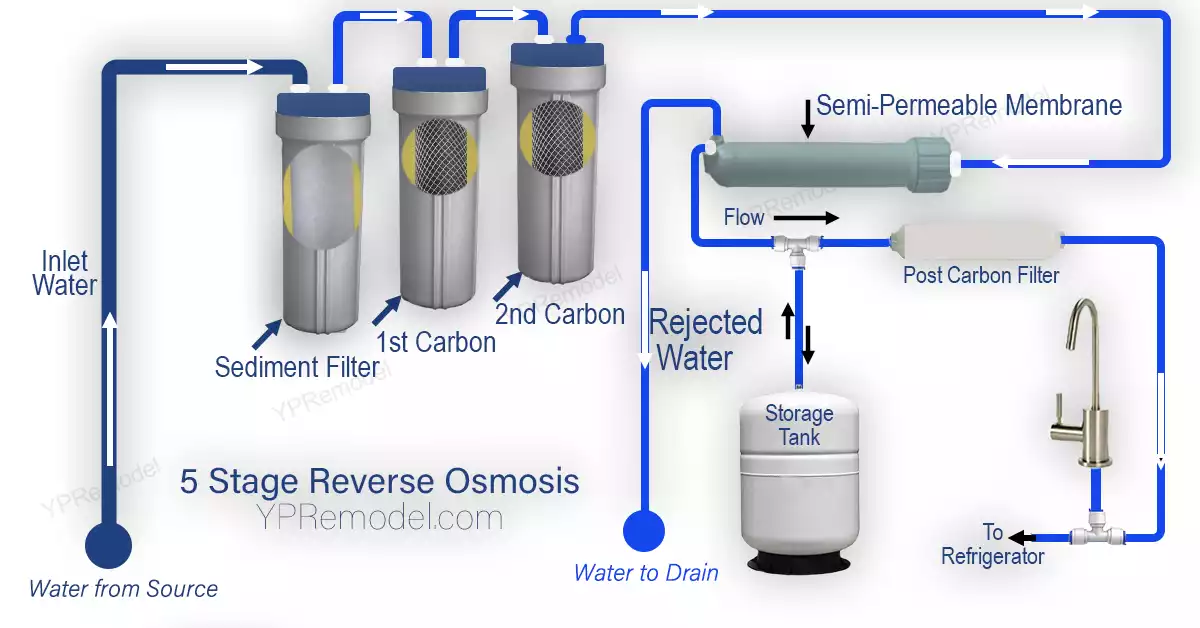
About 5 Stage RO
In a 5 Stage RO, Water Passes through 5 Separate Canisters Each Filtering Unwanted Containments and Wanted Minerals changing the Taste and Smell of Your Drinking Water.
- Will Chlorine Destroy the Membrane? Yes, but the Chlorine is removed in the Carbon Filters before the Membrane.
- Is Coconut a better Carbon filter? Some claim it is better than Coal or Wood. There is a difference in Surface Area and Porosity.
1st Stage is The Sediment Pre-Filter
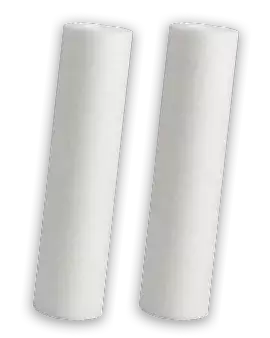
The Incoming Water always has Sediment like Dirt, Sand, Silt, Loose Scale, Clay, Rust, Plastic or anything not dissolved and Suspended like Iron & Manganese. (There are 2 shown, a System normally has 1)
The size of Particles filtered out here vary between Manufactures, it can be from 5 Microns (Micrometers) down to 1. To give you an idea of the size Coffee Filter 20 Microns, Human Hair 70, Dust in the House 40 Microns. Particles smaller than 50 Microns are too Small to easily see without Magnification.
Most Sediment filters are constructed from Multiple Layers of Polypropylene Micro Threads. Polypropylene (PP) is considered Safe, some of its uses include Tupperware, Potato Chip Bags, Food Containers, Diapers and Sediment Filters.
The Number in the Recycling Triangle would be 5. Polypropylene is (Bisphenol A) BPA Free. To my knowledge #'s 3 & 7 may contain BPA. In the List of References below see Mayo Clinic for more Information.
Water enters the Sediment Canister on the outside of the Filter Cartridge and passes through to the Center, the Sediment is Captured in the Filter, the Cleaned Water goes to the Next Stage.
2nd & 3rd Stage - The Carbon Pre-Filters
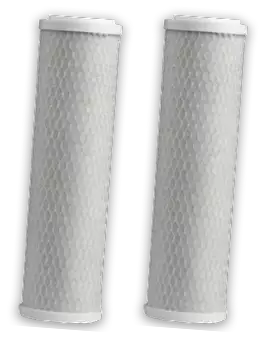
In a 5 Stage RO System there are typically 2 Carbon Filters for the 2 and 3 Stage. The Porosity Ratings can be from 20 down to 5 Microns. Some Systems have 1 Granular and 1 Block Carbon Filter.
There are 3 Sources of Materials used for Carbon Filters: Coal, Wood and Coconut and 2 Forms of Cartridges: Carbon Granular and Carbon Block.
Bituminous Coal is used to make Coal Carbon Filters. The Pores in Bituminous Coal Pores are Larger Thus affecting its Filter ability. These Coal Filters can affect the Waters Taste, by releasing byproducts into the Water, they are still considered Safe.
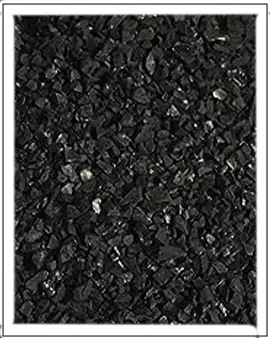
In the Image above Granular Activated Carbon Filters are made from Ground Up Carbon Granules held Loose in a Cartridge. Granular Filters have a Higher Flow Rate compared to Block. Both accomplish Similar Results, the Higher flow rate may not capture an equal amount of Contaminants.
In the Image below the Activated Carbon Block Filter is made by Grinding the Carbon to a Fine Powder up to 20 times smaller than the Granular. The mixture is Heated and Compressed then Extruded with Polymeric Binders to Hold a Desired Shape.
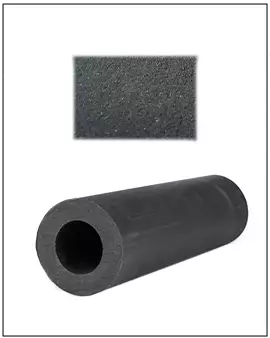
The Process of Grinding, Pressing or Extruding the Carbon Block Filters improves their ability to Filter more Contaminants. The Trade of is slower Flow Rate, but Contaminants are exposed to the Carbon Longer and possibly removing more Contaminants.
Wood Carbon can remove Odor, Taste and Color, the Pore Size is Larger than Coal and unable to filter out Finer Contaminates from Water. Wood is Renewable Source of Carbon.
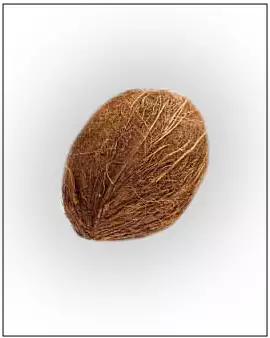
Coconut Carbon, a Newer Form of Carbon Filtration, Density 2 nanometers, Larger Surface Area and More Porosity. Coconut Carbon may be a better Filter absorbing more Unwanted Contaminates and should not alter the Taste. Coconut is Renewable.
Carbon Filters Absorb Containments on their Large Surface area, 1 Gram can equal 1000 Sq Meters or 32,000 Square Feet.
Stage 4 - Semi-Permeable Membrane
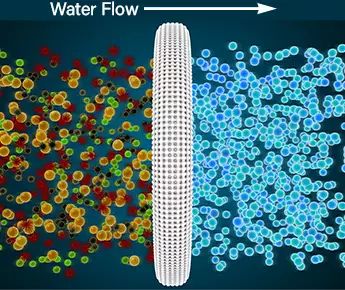
The Membrane is like a Sive or Colander. The Membrane Pore Size, (from the CDC) is approximately 0.0001 Micron, this will allow Molecules of that size to Pass through and Send the Larger Molecules to the Drain.
The Argument is that the Membrane rejects Calcium and Magnesium which are essential to Our Health. Plenty of Arguments For and Against an RO for Drinking Water because of this. Water is not the only way we can get these Minerals. The Lowing of the PH to Acidic is also Argued, Our Stomach's Natural PH (according to UCSF Healt.org) is 1.5 to 3.5. Our Bodies will adjust the PH as Needed. (See Link Below on Stomach Acid)
Stage 5 - The Post Carbon Filter
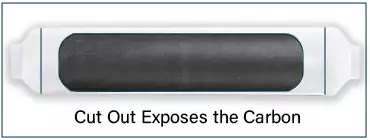
Your Water is almost ready to Drink. This Step is to add another layer of clean up just in case something may have Passed through the Previous 4 Stages. The Post Carbon Filter mostly removes any Unwanted Smells or Taste that may still remain after the Process.
What is Removed
NSF/ANSI 53 Certified Carbon Filters Reduce to Standard acceptable levels or remove: Mercury, Lead, Asbestos, Chlorine, Radon, Benzene, VOC (Herbicides & Pesticides), PFAS (polyfluoroalkyl substances) man made Chemicals, Solvents (trihalomethane Compounds), Odors, MTBE (methyl tertiary butyl ether) and cysts (cryptosporidium) both Parasite & Disease. Cryptosporidium is a Microscopic Parasite that can cause diarrheal disease.
The NSF/ANSI 53 Certification outlines the Requirements to receive the Stamp of Certification. All Products should be clearly marked to assure the Public of what their Product is capable of. Be certain the NSF/ANSI 53 Certification applies to all Components of the RO System, not just 1 Part of the System.
Can Reverse Osmosis have Negative Health affects
The World Health Organization Published an Article on the Negative Effects to Health from the use of RO. Some say there is a Compromise, may be that the bad stuff that is removed out-ways the removal of the Good Stuff that we may already be getting from the Plant Food we Eat. I am not so Quick to Agree.
See our Follow Up to this Statement "Reverse Osmosis and Hydration"
Additional Information and Suggested External Links.
Listed below are Agencies that are Helping set the Standards for Our Drinking Water and The Organizations involved with NSF/ANSI 53 Certifications.
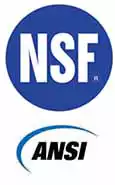
NSF The National Sanitation Foundation, an Independent third-party certification body that tests and certifies products to verify they meet these Public Health and Safety Standards. The (NSF) The National Sanitation Foundation has Established Standards and Protocols for the Safety and Performance of Filters, Purifiers and Reverse Osmosis Systems. (See Link Below to Wikipedia understanding the NSF)
(ANSI) The American National Standards Institute (ANSI) is a private, non-profit organization that administers and coordinates the U.S. voluntary standards and conformity assessment system.
WQA The Water Quality Association, an Illinois-based trade association representing the residential, commercial, industrial, and small community water treatment industry in the United States.
EPA The Environmental Protection Agency, an independent executive agency of the United States federal government tasked with environmental protection matters.
The WaterSense label makes it simple to find water-efficient products, new homes, and programs that meet EPA's criteria for efficiency and performance. WaterSense-labeled products and services are certified to use at least 20 percent less water, save energy, and perform as well as or better than regular models.
Comment Below
Internal Links
External Links The Links Listed were some of the Articles we used in Our Reseach. Each Link is an External Website, you will be leaving the YP Remodel Website.
Like this Article, you can give us a Thumbs just click on the Icon. It's anonymous and we will Thank You.

“Everything comes to him who hustles while he waits”
Thomas Alva Edison
© Copyright 2023 YPRemodel.com. All rights Reserved. This material may not be Published, Broadcast, Rewritten or Redistributed without written Permission.

